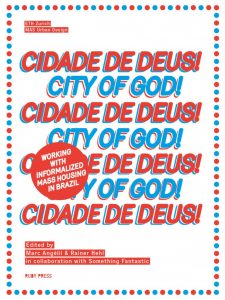City of God
Counter Narrative of Hybrid Formations
An introduction to the publication ‚City of God—Cidade de Deus. Working with Informalized Mass Housing‘
Ruby Press, Berlin 2013
“—Then people from a number of favelas and other towns in the state of Rio de Janeiro came to inhabit the new neighborhood, which consisted of rows of white, pink and blue houses. On the other side of the left branch of the river, The Blocks were built: a complex of blocks of one- and two-bedroom apartments, some blocks with twenty others with forty apartments each, all five stories high. The red shades of beaten earth saw new feet in the hustle and bustle of life, in the stampede of a destiny to be fulfilled.”[1]
Paulo Lins, City of God
Transposed into literature and mass media the story of Cidade de Deus –the City of God, neighborhood of the same name located within the metropolitan region of Rio de Janeiro, has been inscribed in our collective memory. Its violent past that is documented in the book by Paulo Lins and in the movie directed by Fernando Mereilles and Katia Lund became synonymous for the desperate reality of adolescents being dragged into the vicious circle of drug dealing and killing. The overwhelming international success of the movie reinforced the stigma of a whole generation of favela dwellers living in ghettos –parallel worlds beyond law and order.
The revelation of the harsh reality of favelas, informal settlements that seam to be cut-off from the formal organization of the city established a counter-narrative, an alternative vision on everyday life in today’s emerging cities serving as constitutive model-case for the formation of a theory of the subaltern classes.[2]
However, an updated view of on the present situation will tell the story of Cidade de Deus in a different light. With an unprejudiced mind the Master of Advanced Studies in Urban Design of the ETH Zurich started in 2011 a research initiative discovering the multiple aspects and transformation processes of an area that have been freed from the control by the drug mafia in 2009. Looking now at the modifications and extensions of the original settlement reveals the transformative potential of informal practice. Against the dystopian nature of the preceding narratives, a first diagnosis of the current condition has been surprisingly positive.
Did the talk about crime just overshadow the fact that Cidade de Deus has grown over time from an suburban commuter settlement into a lively popular neighborhood with compact urban structures, well-located in close distance to the new urban expansion zone of Barra da Tijuca and the mayor facilities of the upcoming Olympic Games in 2016?
Considering the complete picture, Cidade de Cidade de Deus cannot be seen as a typical case. Developed by governmental agencies in the 1960s the settlement was originally built for the relocation of residents from favela removals. While standardized mass housing was held for solving the problem of illegal constructions (squatting) and uncontrolled urban growth, the conflict at stake was just moved from the center to the periphery of the city multiplied by the remoteness of the new locations. The standardized housing units were informalized over time and Cidade de Deus turned into a favela facing an increase in urban violence after the end of the military regime. Affected by the economic downturn of the ‚lost decade‘ of the 1980s and by the lack of control by public authorities the area was soon to be known as one of the most violent places in Rio if not in Brazil. However, what was to be considered as a hopeless case underwent a major change in wake of recent transformations and Brazil’s efforts assuming its new role as an emerging world power.
Due to the pacification of Cidade de Deus in 2009 we can now discover the positive impact of its informal practice that has been obscured over decades by a biased view on the disastrous consequences of exclusion and social neglect.
‚Cidade de Deus —Working with informalized mass housing in Brazil‘ is looking at a phenomenon that does not pertain to existing categories of urban development. The hybridization of formal and informal practice serves here as a starting point for an investigation on a new role model for urban growth —one that is equally driven by bottom-up and top-down processes. Through research and project proposals the MAS Urban Design is learning from the existing case and testing the performative potential of this new role model deciphering innovative solutions as found as well as proposing new projects.
Driven by the fascination for self-organizing systems and everyday life in informal neighborhoods the present book can be read as a plea for the programmatic qualities and the casual beauty of popular Brazilian architecture.
Rainer Hehl
[1] Lins, P. 2006, City of God, Black Cat Publishers, New York, translated by Alison Entrekin, p.7
[2] Ananya Roy describes in her essay Slumdog Cities: Rethinking Subaltern Urbanism about the creation of new type of narrative of the subaltern through media and tourism. While this new type of narration is tracing new itineraries of recognition it is also presenting subaltern as an urban asset, the only vast tract of land left, that can be made available for fresh construction activities. See: Roy, A. 2011,’Slumdog Cities: Rethinking Subaltern Urbanism’, in: Angélil, M., Hehl, R. 2011, Informalize!, Ruby Press, Berlin
